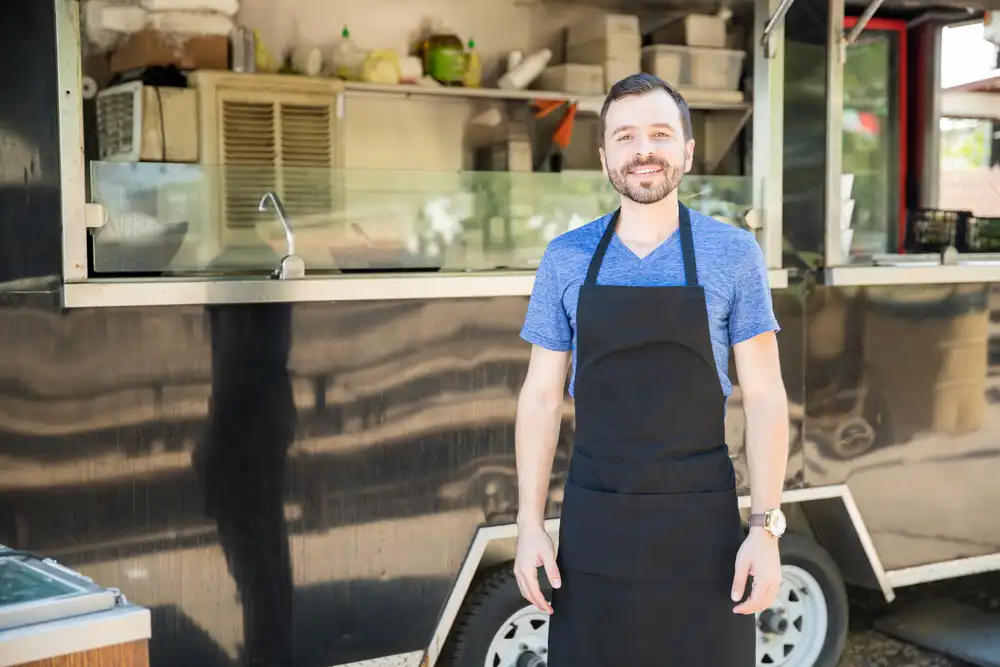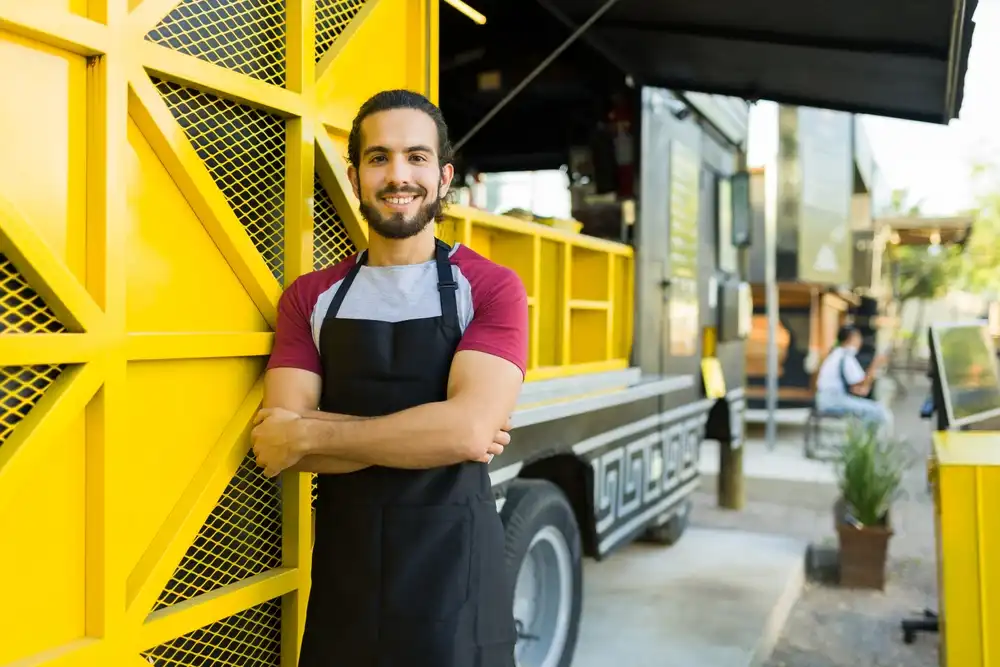How to Start a Food Truck Business
You've seen 'em, you've debated what it would be like, and now you want to be one of 'em. Food trucks are a great way to start your own business and be your own boss. But how do you get started? In this article, we will cover the basics of starting a food truck business, including costs, permits, and key steps to get started.
Tauseeq Magsi
loading...

How Much Does a Food Truck Cost and What to Expect When Starting One
The food truck industry is growing fast. It's seen as a lower-cost, flexible option compared to opening a full restaurant while reaching more customers by bringing food to them.
Many people looking to break into the food world—whether as cooks or investors—are asking the same questions: how to start a food truck and how much does a food truck cost?
These questions are important, especially if you're still researching whether this business is the right move for you.
This guide is here to help.
We'll walk you through the startup process, typical costs, and what daily life running a food truck really looks like. We'll also answer questions like how much do food trucks make, how much is a food truck, and what you need to get legally set up.
If you're thinking about joining this fast-moving business, read on. This article covers everything you need to know before you commit to launching your first food truck.
Is the Food Truck Business Worth It?
Food trucks are gaining popularity across the United States.
A recent report by the Future Market Insights says that the world market for mobile food services was worth about USD 24.9 billion in 2025. It is expected to reach USD 43.0 billion by 2035, growing at a rate of 5.6% per year.
With the market growing steadily, showing this potential in your business plan or investor talks can be key to launching your first food truck.
But before jumping in, it's smart to ask the key question: how much do food trucks make?
On average, food trucks in the U.S. bring in around $250,000 to $500,000 per year in revenue. Profit depends on several things like food costs, staff pay, location, and how well you run the business.
Many owners say they break even or turn a profit within one to two years. Keep this in mind when forecasting growth and talking to investors—they'll expect you to address it in your business plan.
Below, we'll show you all of the major points that you should consider when launching your first food truck. You can use these points as a guide when creating your food truck business plan.
Let's get started!
What Is the Food Truck Startup Cost?
So, how much does a food truck cost? The answer depends on a few factors, which we've sourced from an article by Shopify:
💰💰💰 A new, fully-equipped truck: $75,000 - $200,000
💰💰 A used food truck: $50,000 - $100,000
💰💰💰 A custom build (converting a vehicle): $50,000 - $200,000
💰 A Rented Food Truck: $2,000 to $3,000 monthly
Wondering how much is a food truck? The food truck itself is the largest expense, but there's more:
| Item | Estimated Cost (USD) |
|---|---|
| Food Truck (used or new) | $40,000 – $175,000 |
| Permits and licenses | $500 – $5,000 |
| Equipment and appliances | $10,000 – $30,000 |
| Commissary rental | $500/month – $1,500/month |
| POS (point-of-sale) system | $500 – $2,000 |
| Branding and wrap | $2,500 – $6,000 |
How Long Does It Take to Start a Food Truck?
Once you've decided to start, expect at least 3–6 months to get everything ready.
Here's a general timeline:
1. Planning and business setup
approximately 2 to 4 weeks
2. Buying and outfitting your truck
approximately 1 to 3 months
3. Permits, licenses, and inspections
approximately 1 to 2 months
4. Hiring and test runs
approximately 2 to 4 weeks
Total time: 3 to 6 months from idea to opening day
Daily Operations of a Food Truck: What's Different from a Restaurant?
Running a food truck is not the same as running a traditional restaurant. There are a few key differences that new owners should be ready for.
Here's what makes food trucks unique:
1. Weather
Food trucks operate outdoors. This means your sales can take a hit during bad weather like heavy rain, snow, or strong winds.
Unlike a restaurant with indoor seating, your food truck relies on walk-up customers. You'll need a plan for weather-related slowdowns.
Cities like Chicago, Denver, and Minneapolis all deal with long winters and unpredictable weather. But food truck owners there still find ways to make it work.
Many set up near indoor events or switch to warmer locations during colder months. Some trucks use canopies, tents, or outdoor heaters to help customers stay comfortable while waiting.
Others adjust their hours and use social media to update customers when weather changes plans.
2. Parking
You can't just park your food truck anywhere. Most cities have zoning rules, parking permits, and time limits for where and when food trucks can operate.

Some cities allow parking in commercial zones but restrict residential areas. Others require trucks to move every few hours. You might also need special permits for parks or public spaces.
Before launching, research local ordinances, health regulations, and permit costs. Check with your city's health department or local food truck association. Cities like Los Angeles, Austin, and Portland have dedicated food truck parks and pods that provide easy access, parking spots, and steady foot traffic.
Choosing the right location affects how visible you are and how much foot traffic you get.
3. Commissary Kitchen
If you're learning how to start a food truck, you'll find out quickly that a commissary kitchen is often required.
What is a commissary? A commissary is a shared commercial kitchen that's licensed and inspected for food production. These spaces allow food trucks to prep ingredients, cook, clean, store dry and cold goods, and refill fresh water. Many also provide dishwashing stations, secure storage, and waste disposal.
Health departments in many cities—like Los Angeles, New York City, San Francisco, and Chicago—won't let you prep or store food in your truck alone.
Using a commissary helps ensure food safety and compliance with local laws. It's also where many trucks dump waste, clean grease traps, and handle gray water.
Commissary fees vary by city and kitchen size. Expect to pay between $1500 and $2,500 per month, depending on services. Look for kitchens that are close to your service area to save time and fuel.
4. Waste Management
Running a mobile kitchen means managing trash, gray water, and grease the right way.
Health departments in most states—including California, Texas, Florida, New York, Illinois, and Washington—require food trucks to dispose of waste like grease, gray water, and trash at approved facilities.
This includes used cooking oil, gray water from sinks, and all solid waste. If your commissary doesn't handle waste, you'll need to find a licensed company to haul it away.
Skipping this step can lead to fines or even permit suspension.
It's a good idea to set up a regular schedule for waste removal. That way, you don't run into problems on busy days.
Always track how much waste your food truck produces so you can adjust services as your business grows. A clean food truck not only keeps inspectors happy—it also builds customer trust.
5. Crew Size
A lot of people ask if they can run a food truck solo. While that's possible for small operations, most new owners find it easier to start with a full team. Having extra help can make a big difference on opening day or during events.
A good crew size for launch is four people:
👨🍳 One person to cook
👨🍳 One to take orders and serve food
👨🍳 One to handle trash and clean the work area
👨🍳 One flexible helper to assist wherever needed
This setup helps you stay organized and serve customers quickly.
Over time, you can decide if you want to scale up or streamline. If you're operating in a high-traffic area or attending festivals, you might need even more hands on deck.
Training your team to handle different roles also gives you flexibility when someone calls in sick or you hit a rush.
6. Seating and Dining
Seating is often overlooked, but it can make a big difference in how customers experience your food truck.

Some food trucks offer basic folding tables, stools, or nearby benches. Others stick to walk-up service, especially if they're targeting office workers or busy downtown crowds who prefer grab-and-go meals.
Whether or not you provide seating depends on your location, space, and customer habits.
In urban areas like New York City or San Francisco, space is tight, and most customers just want fast service. In more open settings like parks, festivals, or food truck roundups in cities like Austin or Nashville, having a seating area can keep people around longer and even boost sales.
✅ If you're parking in one spot for long hours, offering some kind of seating—like folding chairs, picnic tables, or bar stools—can help create a welcoming vibe.
✅ For events and fairs, ask if the organizers provide seating, or if you're allowed to bring your own.
✅ Make sure your seating is safe, clean, and easy to pack up when needed. Lightweight, stackable options are great for tight spaces.
✅ Consider the weather too. If you serve in sunny or rainy spots, you might want umbrellas or small tents to offer shade or shelter.
How to Legally Set Up Your Food Truck: Permits, Licenses, and Business Requirements
Before you start selling, you'll need to set up your business legally.
Every state and city has its own rules, so double-check with your local government before launching. Make sure to keep track of all license renewal dates and inspection schedules.
Here are the main steps on how to start a food truck:
Step 1: Choose a Business Entity
Decide whether you want to operate as a:
- sole proprietorship
- partnership
- limited liability company (LLC)
- corporation
A sole proprietorship means there's no legal separation between you and the business—you're personally responsible for all debts, and your personal assets could be at risk if the business is sued.
A partnership is when two or more people share the business's responsibilities and liabilities.
An LLC protects your personal assets and is easier to manage than a corporation.
A corporation is a separate legal entity that offers the most protection but has some additional costs for filing fees and paperwork.
Step 2: Get a Federal EIN (Employer Identification Number)
This is like a Social Security Number for your business. You'll need it to open a bank account, file taxes, and hire employees. It's free and only takes a few minutes through the IRS website.
Step 3: Apply for a Local Business License
Almost every city or county requires this license to operate legally. It proves you're allowed to run a business in that area. The application process and cost vary, so search online using your city business license application or visit your city government's website.
Step 4: Get a Mobile Food Vendor Permit
This is specific to food trucks and is required in most cities. It usually involves a health inspection of your truck, fingerprinting, and proof of your commissary kitchen.
Some cities, like Los Angeles and New York City, also require proof of parking arrangements.
Check your city's health department for rules.
Step 5: Pass a Health Department Inspection
You must follow food safety rules like proper food storage, clean surfaces, and temperature control. Health inspectors will visit your truck to make sure it meets local codes. Some cities do this yearly, while others may inspect more often.
Step 6: Get a Fire Department Inspection
If your food truck uses propane, a generator, deep fryers, or any other heat source, this inspection is mandatory.
Fire departments check for safe equipment, proper ventilation, and fire extinguisher placement. Schedule your inspection once your truck is fully outfitted.
Step 7: Register Your Vehicle And Get Commercial Insurance
Your food truck must be registered with your state's DMV. You'll also need commercial auto insurance and general liability insurance. These protect your business in case of accidents or property damage.
Talk to an insurance provider that works with food trucks to find the right coverage.
Takeaway
Plan carefully and know exactly what you need to do to start a food truck business.
To run a food truck successfully, you need to know how much it costs, what you need to do every day, and legal requirements. Every step is important for running a business smoothly, from picking the right business entity to forming strong bonds with important partners like commissaries and waste services.
Understanding “how much does a food truck cost” upfront will help you plan better.

Don't forget how important it is to keep your business safe by getting the right permits and licenses. Building a strong team and figuring out the best places to serve customers will also make a big difference in your success.
When you ask yourself, “how much do food trucks make?”, keep in mind that it takes time to be successful, but your food truck can do well if you plan and get ready for it.
You'll quickly learn how to start a food truck and run a successful business if you stay prepared and follow the rules.
©2025 Cocina Digital Hospitality Group, Inc. All rights reserved.
No part of this publication may be reproduced, stored in a retrieval system, or transmitted in any form or by any means, electronic, mechanical, photocopying, recording, or otherwise, without the prior written permission of the publisher.
We use cookies to enable you to use our site, understand how you use our site, and improve your overall experience.
Cookies allow us to personalize content, track which pages are most popular and least popular, and provide advertising that may be relevant to you.
Please note that cookies that are essential to the proper functioning of the site are required and cannot be disabled.
They are usually only set in response to actions made by you which amount to remembering your settings, a request for services, such as setting your privacy preferences, logging in, or filling in forms.
As such, they are the only cookies that are enabled by default.
You can set your browser to block or alert you about these cookies.
By continuing to use our site, you accept our use of cookies.